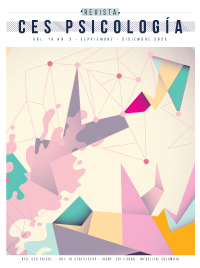Confirmatory factor analysis of the Verbal Identity Fusion Scale in a Chilean sample
DOI:
https://doi.org/10.21615/cesp.6165Keywords:
identity fusion, personal identity, social identity, identity, self-sacrifice, extreme behavior, factor structure, goodness of fitAbstract
Identity fusion consists in a form alignment with a group and is a significant predictor of extreme pro-group behavior. The present study analyzed the factor structure of the verbal scale of identity fusion developed by Gómez et al. (2011), in a Chilean sample. A Chilean university sample by convenience of 411 participants (66% women) with a mean age of 24.45 years (SD = 5.89) was used. One-factor and two-factor fit of the scale was analyzed through factor analysis, and the respective reliabilities. The results indicated a good and better fit of the two-factor (χ2/gl = 3.34, p < .001, CFI = .975, TLI = .957, SRMR = .030, and RMSEA = .085), than the one-factor model, which did not show a good fit (χ2/gl = 5.26, p < .001, CFI = .946, TLI = .919, SRMR = .042, and RMSEA = .116). Both models had high reliabilities (> .800). The better fit of the two-factor structure was discussed in relation to studies conducted in the United States, Spain, and an immigrant population in Chile. The need for future studies incorporating other validity analyses and overcoming the limitation of the present study associated with the use of a non-representative sample is projected.
Downloads
References
Alexandre, N., Gallasch C., Lima M., & Rodrigues R. (2013). Reliability in the development and evaluation of measurement instruments in the health field. Revista Eletrônica de Enfermagem, 15(3), 802-809. http://dx.doi.org/10.5216/ree.v15i3.20776
Ashokkumar, A., Talaifar, S., Fraser, W. T., Landabur, R., Buhrmester, M., Gómez, Á., … Swann W. B. (2020). Censoring political opposition online: Who does it and why. Journal of Experimental Social Psychology, 91, 104031. https://doi.org/10.1016/j.jesp.2020.104031
Besta, T., Gómez, Á., & Vázquez, A. (2014). Readiness to deny group’s wrongdoing and willingness to fight for its members: The role of poles’ identity fusion with the country and religious group. Current Issues in Personality Psychology, 2, 49–55. http://dx.doi.org/10.5114/cipp.2014.43101
Besta, T., Mattingly, B., & Błażek, M. (2015). When membership gives strength to act: Inclusion of the group into the self and feeling of personal agency. The Journal of Social Psychology, 156(1), 56-73. http://dx.doi.org/10.1080/00224545.2015.1053838
Bortolini, T., Newson, M., Natividade, J. C., Vázquez, A., & Gómez, Á. (2018). Identity fusion predicts endorsement of pro-group behaviours targeting nationality, religion, or football in Brazilian samples. British Journal of Social Psychology, 57(2), 346-366. http://dx.doi.org/10.1111/bjso.12235
Buhrmester, M., Fraser, W., Lanman, J., Whitehouse, H., & Swann, W. (2014). When terror hits home: Identity fused Americans who saw Boston bombing victims as ‘family’ provided aid. Self and Identity, 14, 253–270. http://dx.doi.org/10.1080/15298868.2014.992465
Fredman, L., Buhrmester, M., Gómez, Á., Fraser, W., Talaifar, S., Brannon, S., … Swann, W. (2015). Identity fusion, extreme pro-group behavior, and the path to defusion. Social and Personality Psychology Compass, 9, 468-480. http://dx.doi.org/10.1111/spc3.12193
Gómez, Á., Brooks, M., Buhrmester, M., Vázquez, A., Jetten, J., & Swann, W. (2011). On the nature of identity fusion: Insights into the construct and a new measure. Journal of Personality and Social Psychology, 100, 918–933. http://dx.doi.org/10.1037/a0022642
Gómez, Á., Chinchilla, J., Vázquez, A., López‐Rodríguez, L., Paredes, B., & Martínez, M. (2020). Recent advances, misconceptions, untested assumptions, and future research agenda for identity fusion theory. Social and Personality Psychology Compass, 14(6), 1-15. https://doi.org/10.1111/spc3.12531.
Gómez, Á., Morales, J., Hart, S., Vázquez, A., & Swann, W. (2011). Rejected and excluded forever more, but even more devoted: Irrevocable ostracism intensifies loyalty to the group among identity fused persons. Personality and Social Psychology, 100(5), 918–933. https://doi.org/10.1037/a0022642
Gómez, A., & Vázquez, A. (2015). The power of ‘feeling one’ with a group: Identity fusion and extreme pro-group behaviors. International Journal of Social Psychology, 30, 481–511. https://doi.org/10.1080/02134748.2015.1065089
Gómez, Á., Vázquez, A., López-Rodríguez, L., Talaifar, S., Martínez, M., Buhrmester, M. D., … Swann Jr, W. B. (2019). Why people abandon groups: Degrading relational vs collective ties uniquely impacts identity fusion and identification. Journal of Experimental Social Psychology, 85, 1-16. https://doi.org/10.1016/j.jesp.2019.103853
Gosling, S., Vazire, S., Srivastava, S., & John, O. (2004). Should we trust web-based studies? A comparative analysis of six preconceptions about internet questionnaires. American Psychologist, 59(2), 93-104. https://doi.org/10.1037/0003-066X.59.2.93
Hair, J., Anderson, R., Tatham, R., & Black, W. (1999). Análisis multivariante. (5° ed.). Prentice Hall.
Henrich, J., Heine, S. J., & Norenzayan, A. (2010). Most people are not WEIRD. Nature, 466(7302), 29. https://www.nature.com/articles/466029a
Henríquez, D., Urzúa, A., & López-López, W. (2019). Fusión de identidad en migrantes: análisis psicométrico de la escala verbal. Suma Psicológica, 26(2), 86-93. http://dx.doi.org/10.14349/sumapsi.2019.v26.n2.4
Henríquez, D., Urzúa, A., & López-López, W. (2020). Identity fusion: A systematic review. Acta Colombiana de Psicología, 23(2), 383-409. https://doi.org/10.14718/ACP.2020.23.2.15
Jiménez, J., Gómez, Á., Buhrmester, M., Vázquez, A., Whitehouse, H., & Swann, W. (2015). The dynamic identity fusion index: A new continuous measure of identity fusion for web-based questionnaires. Social Science Computer Review, 34, 215–228. https://doi.org/10.1177/0894439314566178
Kong, F. (2017). The validity of the Wong and Law Emotional Intelligence Scale in a Chinese sample: tests of measurement invariance and latent mean differences across gender and age. Personality and Individual Differences, 116, 29–31. https://doi.org/10.1016/j.paid.2017.04.025
Kunst, J. R., Boos, B., Kimel, S. Y., Obaidi, M., Shani, M., & Thomsen, L. (2018). Engaging in extreme activism in support of others’ political struggles: The role of politically motivated fusion with out-groups. PloS one, 13(1), 1-30. https://doi.org/10.1371/journal.pone.0190639
Landabur, R., Miguez, G., Laborda, M., & Salinas, M. I. (2022). Why do people self-sacrifice for their country? The roles of Identity fusion and empathic concern. PsyCh Journal, 11(1), 55-64. https://doi.org/10.1002/pchj.495
Mardia, K. V. (1974). Applications of some measures of multivariate skewness and kurtosis in testing normality and robustness studies. Sankhyā: The Indian Journal of Statistics, 36, 115-128.
Miaja, M., Moral, J., Fonseca, A., Cruz, M., Villarreal, C., Becerril, A., … Ferrigno, A. (2021). Factor structure, internal consistency and distribution of Female Sexual Function Index among Mexican women with early diagnostic of breast cancer. Psicooncología, 18(2), 293-316. https://revistas.ucm.es
Mohsin, N., Mourad, G., Faure, M., Szawarc, I., & Bringer, J. (2013). Metabolic syndrome performs better than the individual factors in predicting renal graft outcome. Transplantation proceedings, 45(10), 3517–3519. https://doi.org/10.1016/j.transproceed.2013.09.013
Muthén, L. K., & Muthén, B. O. (1998-2017). Mplus User’s Guide. (8° ed.). Muthén & Muthén.
Paolacci, G., Chandler, J., & Ipeirotis, P. (2010). Running experiments on Amazon Mechanical Turk. Judgment and Decision Making, 5(5), 411–419. Recuperado de https://repub.eur.nl.
Rosseel, Y. (2012). Lavaan: An R package for structural equation modeling. Journal of Statistical Software, 48(2), 1–36. https://doi.org/10.18637/jss.v048.i02.
Ruiz, M., Pardo, A., & San Martín, R. (2010). Modelos de ecuaciones estructurales. Papeles del Psicólogo, 31(1), 34-45. Recuperado de http://www.papelesdelpsicologo.es.
Schreiber, J. B. (2017). Update to core reporting practices in structural equation modeling. Research in Social and Administrative Pharmacy, 13(3), 634-643. http://dx.doi.org/10.1016/j.sapharm.2016.06.006.
Schreiber, J. B., Nora, A., Stage, F. K., Barlow, E. A., & King, J. (2006). Reporting structural equation modeling and confirmatory factor analysis results: A review. The Journal of Educational Research, 99(6), 323–337. http://dx.doi.org/10.3200/JOER.99.6.323-338.
Swann, W. B., Jr., Buhrmester, M., Gómez, Á., Jetten, J., Bastian, B., Vázquez, A., … Zhang, A. (2014). What makes a group worth dying for? Identity fusion fosters perception of familial ties, promoting self-sacrifice. Journal of Personality and Social Psychology, 106(6), 912–926. https://doi.org/10.1037/a0036089
Swann, W. B., Jr., Gómez, Á., Buhrmester, M., López-Rodríguez, L., Jiménez, J., & Vázquez, A. (2014). Contemplating the ultimate sacrifice: Identity fusion channels pro-group affect, cognition, and moral decision making. Journal of Personality and Social Psychology, 106(5), 713-727. https://doi.org/10.1037/a0035809
Swann, W. B., Jr., Gómez, Á., Dovidio, J., Hart, S., & Jetten, J. (2010). Dying and killing for one’s group: Identity fusion moderates responses to intergroup versions of the trolley problem. Psychological Science, 21, 1176–1183. https://doi.org/10.1177/0956797610376656
Swann, W. B., Jr., Gómez, Á., Seyle, C., Morales, J., & Huici, C. (2009). Identity fusion: The interplay of personal and social identities in extreme group behavior. Journal of Personality and Social Psychology, 96, 995-1011. https://doi.org/10.1037/a0013668
Swann, W. B., Jr., Jetten, J., Gómez, Á., Whitehouse, H., & Bastian, B. (2012). When group membership gets personal: A theory of identity fusion. Psychological Review, 119, 441-456. https://doi.org/10.1037/a0028589
Tajfel, H. (1974). Social identity and intergroup behaviour. Social Science Information, 13(2), 65-93.
Tajfel, H., & Turner, J. (1979). An integrative theory of intergroup conflict. En W.G. Austin y S. Worchel (Eds.), The Social Psychology of intergroup relations (pp. 33-47). Brooks- Cole.
Turner, J.C., & Reynolds, K. (2012). Self-categorization theory. En P. Van Lange, A. Kruglanski & E. Higgins (Eds.), Handbook of Theories of Social Psychology (pp. 399-417). SAGE.
Whitehouse, H., McQuinn, B., Buhrmester, M., & Swann, W. (2014). Brothers in arms: Libyan revolutionaries bond like family. Proceedings of the National Academy of Sciences, 111, 17783-17785. https://doi.org/10.1073/pnas.1416284111
Yzerbyt, V., & Demoulin, S. (2010). Intergroup relations. En S. Fiske, D. Gilbert & G. Lindzey (Eds.), Handbook of Social Psychology (pp. 1024-1083). John Wiley & Sons.
Downloads
Published
How to Cite
Issue
Section
License
Copyright (c) 2022 Rodrigo Landabur Ayala, Gonzalo Miguez Cavieres, Mario Laborda, María Salinas

This work is licensed under a Creative Commons Attribution-NonCommercial-ShareAlike 4.0 International License.
Each manuscript is accompanied by a statement specifyingThat the materials are unpublished, that have not been previously published in printed formatElectronic and that they will not be presented to any other means before knowing the decision of the magazine. ThroughoutIn case, any previous publication, sea in printed or electronic form, must be made known to the editorial staffWriting The authors attach a signed statement stating that, and the manuscript is acceptedFor publication, the rights of reproduction are the exclusive property of the Journal CES Psychology.| Article metrics | |
|---|---|
| Abstract views | |
| Galley vies | |
| PDF Views | |
| HTML views | |
| Other views | |




